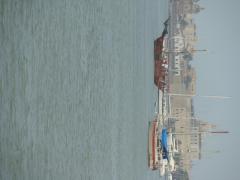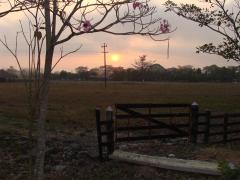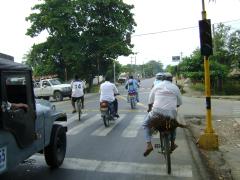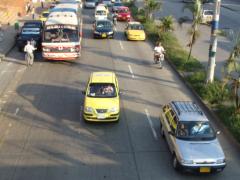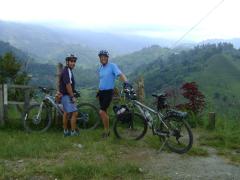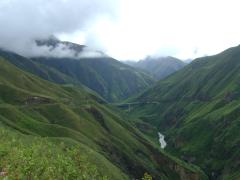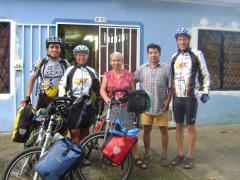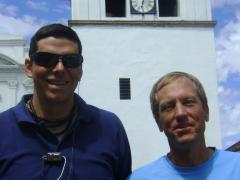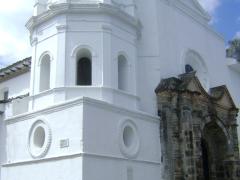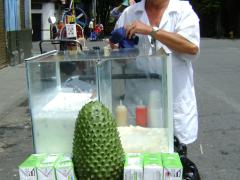Nancy's remembrances of Colombia
About a year ago Randy and I started talking about the pros and cons of riding through the most northern country of South America. We all know that Colombia has had a bad reputation for years because of narcotrafficking, the FARC guerrilla organization, paramilitary groups, kidnapping, etc. We even told our family members we would skip this country and fly straight to Ecuador. After reading the wonderful adventures of other cyclists who dared to enter the foreboding country we started to understand things have changed for the better of the last few years. The most current reports tell how Colombia has gone and is still going through a great metamorphosis. Much of the change can be attributed to the President, Álvaro Uribe, who is determined to make Colombia a safe place after more than 40 years of conflict.
The following is my impression of Colombia during our bicycle ride in May 2008.
We entered the seaport of Cartagena after sailing from Panama. The cityscape looked like a mixture of Quebec, Canada, Miami, Florida, and New Orleans, Louisiana. Cartagena is surrounded by stone fortresses built to protect the city from years and years of pirate attacks that the city endured in the time that it was a key treasure port for the Spanish. Currently there is an astonishing number of new skyscrapers being built -- I counted over 20 huge cranes hanging over the city´s waterfront, a sure sign of prosperity and growth.
The old part of Cartagena is a wonderful colonial city with every building painted stark white and with black wrought-iron metalwork covering the windows and red tile roofs spread out as far as the eye can see. The city has a feel of New Orleans: lively, musical, colorful vendors, and a tad bit on the seedy side which adds to its character. We did not do this city justice as far as visiting all the sites but we did have a good look around. The highlight of the afternoon was the the Naval Museum, in the southwest corner of the city walls in the the Plaza de la Marina. What I liked most was the 1/16th scale sailing vessels from all over the world. But my all time favorite was Gloria, a real stuffed dog who once was a mascot to a commander in the Navy. The dog had more articles written about its life story then the commander.
We were itching to get on the road again, so we headed out to explore South America after visiting Cartagena for only one and a half days. We headed west along the coast of the Colombian Caribbean. What I remember most about this part of the trip was the mango trees, the flat land and the incredible heat. Oh the heat! One day Randy´s bike thermometer read 112 degree Fahrenheit which equals 44 degrees Celsius. We would get up at 4:00 in the morning so we could be riding by first light and try to beat the heat which became very hot by mid morning. Some days we would be wasted by heat exhaustion and having a nap along the side of the road by 10:30 in the morning. The early morning rides were delightful, comfortable and the humid lowlands made for long fiery sunrises.
We stayed on the Pan-American highway all the way through Colombia because we were advised that it would be safe for two cyclists like us. It turned out to be very safe because it is secured by hundreds of military checkpoints. The purpose of the stops are to check vehicles for drugs, weapons, kidnap victims and an assortment of other illegal activities. In any one day we would ride by one to ten controlled checkpoints. I guess we looked harmless so most of the time we were waved through. I often thought that if we were smugglers our disguise was a great one because not once were we stopped for a check of our bags. Once in while military personnel would wave to us to stop because they wanted to know about our trip, like where we we from or where are we going or why are you doing this. We stopped at one check point to ask for directions and ended up talking to the group for about 15 minutes. After giving the top commander one of our business cards, he gave us a present in return. I thought he was reaching for something in his jacket pocket but he was just putting away our card. He leaned over and gave Randy and me a huge bear hug and best wishes on our travels.
Most of the military were young men doing their compulsory year of service. We would just wave at them as we rode by and look to see if anyone wanted us to stop for a check. Some of the military men waved back, others just looked at us and while many just ignored us and kept talking on their cell phones. I wondered if the military personal gets free cell service because of the young men seemed to spend a lot of time on the phone. It's probably a way to take away the boredom. Only once did we have to halt our progress for the day because of potential conflict. There was a demonstration by campesinos whose coca fields were being destroyed by the US-led plan to destroy illicit crops. However, they have no income to replace their former living, and are quite upset, so created a roadblock on the highway.
It was late in the day and the young men at the military checkpoint told us to hang it up for the day. We found a hotel for the night and continued in the safety of the daylight. I was a little tense riding through the small town that was under military control. What we found out was that two days earlier there had been a skirmish between the campesinos and the military during a protest where one person died and several were hurt. I must admit I was tense as we were waved passed the road block by the riot squad and into the small town of Taraza. I remember seeing the charred remains of tear gas, spent metal parts and burnt tires scattered through out the towns main street. It was the closest I had ever come to a war zone and I was scared. Randy jokingly said we should stop for breakfast. I said "no way" and we rode on toward a more tranquil part of Colombia. I took my first deep breath about 15 miles past the town and did not stop sweating for another 10 miles.
The people of Colombia are great lovers of sports of all kind. Soccer, billiards, skating, bull fighting but especially cycling. In the first hour of our riding out of Cartagana we saw more sports cyclists than we had seen in all of Central America and Mexico combined. We even rode with a couple who rode every morning with a group of friends. When we stopped, the group gathered for a photo with the gringo cycle tourists. They had so many questions we did not know which one to answer first. From then on every time we neared a city we would see dozens and dozens of cyclists riding with full professional gear. They would ride with us and want to hear our stories. They would ride two or three abreast blocking traffic with no worries. The traffic just went around them with no problems.
The roads of Colombia belong to everyone. The dogs, the horses, the cows, the cyclists, the motorcyclists, the cars, the buses, the trucks, the semis, and us. They drivers drove slow and the Pan-American highway had a nice shoulder most of the time. It was a pleasure to ride this country because of the Colombians' huge respect and support for cycling. We received many thumbs up and waves from all sorts of drivers, cyclists and people throughout Colombia. I often felt like a queen, and I know the queen of England would be green with envy.
My general impression is that Colombia is a well-developed country with the majority being educated and more affluent then most Latin American countries we've visited. I do not mean there is no poverty because there are many people who are living way below the poverty level. But a majority seems to be able to afford either bicycles or motorbikes as forms of transportation. There is good bus transportation in the cities as well as the country all which seem to have good emissions. Colombia has a good medical system and appears to have less crippled and maimed people throughout the country. The cities of Medellin and Cali are world centers for plastic surgery of any kind because of the advanced technology and lower prices. The LASIK technique was actually developed by a Colombian, Jose Barraquer, around 1950.
I even got a quote for some alteration with plastic surgery. To tighten up my skin and to reverse the current sun damage to my face, I could have a Botox treatment for about US$400. I could have a total alteration for around US$10,000, including a face lift, chin tuck, breast implants, arms firmed up, a belly tuck, and some liposuction around the buttocks and thighs. It would take a couple of months of healing before I could get on my bike and continue my trip. Since we do not want to interrupt our current forward motion, I decided I will come back for a full treatment in two years. By that time I may not need any of the treatment because I will be in awesome shape.
We had the incredible fortune of staying with four different host families who are members warmshowers.org. Each host offered us different insights to life in Colombia. All which we are very grateful for the enriching experience.
We stayed with Jon and Ivo in Manizales, a young newly web couple from two different countries. Ivo is a well educated Colombian from Bogota and Jon is from Minnesota working as a teacher in a bilingual school in Manizales. They taught us a lot about the local culture both from the gringo point of view and a Colombian point of view.
We also visited Gonzalo in Armenia where we stayed on his familiy's finca, a Colombian fruit farm growing platanos. Platanos look like huge bananas but require cooking.. We were well cared for by the caretaker family, especially Nelcy, who cooked traditional Colombian food over a wood burning stove. Every meal we had bananas prepared many different ways. It was very peaceful staying out on the finca and we were treated like royalty.
Gonzalo took us mountain biking and I'll never forget it, because of the stunning back roads we explored that took us through green rich fertile areas, past banana plantations, up and over mountain ridges and to one of the most scenic villages in Colombia. In Salento we stopped for an excellent lunch of trout which was wonderful, beautiful and cheap (Bueno, Bonito Y Barato). We topped this off with a fruit cocktail that I thought was one of the best foods in Colombia, The salpicon had a dozen different fruits in natural juices. Oh, it makes my mouth water thinking about it. After lunch we went for the second half of the ride which I will always remember as the muddy slot. Because it was the rainy season the single track we descended was only doable by walking our bikes down. It was just a tunnel of mud that made no sense to be on and especially with bikes. At one time I had to step down the steep path backwards with my bike held uphill as I slipped backwards down the mucky way. After 30 minutes we reached the pavement and by that time I had enough of mountain biking in Armenia but our host was not finished yet. We washed our bikes in the stream after after I expressed I had enough of forward motion we headed home, which I thought would be along the pavement and the short way home but no, we went along the back muddy roads full of extremely beautiful landscape with fruit trees, cornfields, canyons, forests and streams. We finished the ride in the pouring rain. Ever bit of us was soaked but the rain had washed off the 25 miles of dirt we had collected in the rugged back roads of Colombia. It was the "Tour de Excellency de Armenia". That night we shared a meal with the Gonzalo, his mom and his aunt at the finca, of course prepared by Nelcy. We talked for hours of what life has been like in this part of Colombia a long time ago and how it has changed over the years. We talked about coffee, bananas, fruit growing, cultural difference for women and so much more. Again this provided us another view of life in Colombia.
At this point we rode on through the challenging Colombian Andes. We were starting to get in shape and are riding well. And it's a good thing to be riding strong under the "shadows of the giants". Every day we climbed to immense heights and descended enormous slopes. The weather was gentle on us and waited until we reached a place to stay at night. When we were not staying with a host we stayed in hotels which for the most part were quite decent and on the average are higher quality then other places in Latin America we have stayed in. Clean, well lit, have bathrooms with toilet seats, nicer beds though hard, nice sheets and blankets, clean and cheap for an average of $8 or $10 a night. The cheapest was $7.00 and the most was $25.00 We stayed a few places near discoteques which were very loud and stayed open until 4:00am. In this case we got out our earplugs. The people love dancing and music which is everywhere. We now make sure our hotels are not near a discoteque.
We next visited Cali and stayed in a Casa de Cyclistas which offers hospitality to cyclists. Miller Hernan and family open up their humble home to traveling cyclists like us. They offered a nice place for us to set up our tent which was great because it was cooler sleeping outside. We had use of the kitchen, a bathroom with a cold shower and a nice family experiences. We stayed there during the Mother´s Day weekend and felt welcome as if we were part of the family. The family has limited resources but has a richness that is shared openly and eagerly. For a Mother's Day present, everybody else in the house jumped in and took over the day's chores. Miller and I went to the farmer's market at 6:30 in the morning and bought all the makings for the a speciality soup called ajiaco. It took several hours of preparation and several more hours cooking over a wood burning fire, and was delicious.
We stayed a couple of days and explored the city with Miller and a new friend Jose and his son Juan who all are biking enthusiasts. Jose and Juan spent a half a day showing us all the highlights of Cali. Jose is currently organizing the second annual bike tour of Colombia called Colombia Nuestra Meta which translates as Colombia is our goal. He even gave us very, very nice cycling jersey. We now have a sponsor, more or less. If I can say so myself we look so cool. You will be seeing photos of us wearing our fancy jersey in famous places like the Equator and Macchu Picchu.
Our next major stop was at Popayan where we stayed with Santiago and his family. The family would be considered upper middle class in any culture. They live in a two story apartment in the middle of Popayan. Both Santiago and Marta are hard working folks, have one daughter whose beautiful name is María Camila, also a small chihuahua dog and a live-in servant. Santiago gave us a complete tour of Popayan including the dozen of churches and we were tested on all the names of the churches.
Let´s see if I remember all of them: San Francisco, Santo Domingo, La Ermita, San Agustin, San Jose, La Encarnacion, Cathedral Basilica Nuestra Senora de la Asuncion, Belen, El Carmen. There are as many churches as there are banks in this medium size town of 250,000. The buildings in the historic center, like Cartagena, are all painted white. Of all the places we visited in the 6 weeks in Colombia, Popayan is my favorite. Perhaps it was how well we were treated by our very generous hosts. We were treated to a fine dinning experiences at a posh restaurant serving fine typical local food. Santigo and family we thank you very much for sharing a few days in your lives and educating us about the fine people and town of Popayan.
The last week was full of more climbing and descents and rain. As we approached Pasto the weather did not hold back any more and the dreaded rain tested our spirit and followed us into Ecuador. But all and all the weather was great for the majority of time, the food and fruits terrific and the people were the highlight of our visit in Colombia.
My general impression is that Colombia is a well developed country with the majority being educated, more affluent then most Latin American countries. I loved all the different fruits like lulu, mora, guayba, and the ice creams and juices made from the exotic fruit.
The food was varied enough from location to location to be an adventure by itself.
What I will remember the most about Colombia is the absolute friendliness we experienced as cycle tourist. The country loves cycling and supports it in so many different ways. First of all the drivers seemed to give us plenty of space and shared the road with everyone. The huge number of cyclists of all kind is very impressive from the sports enthusiast to the worker, the commuters, the townspeople doing their errands.
Colombia is has many riches and is a very developed country that one day will get the respect from around the world that it deserve as a first class place to visit and live.

